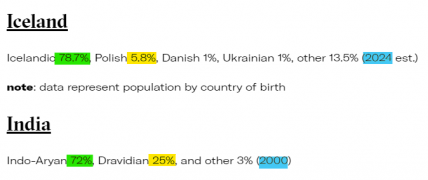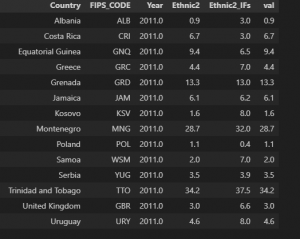CIA World Factbook: Difference between revisions
Kexin.Shang (talk | contribs) mNo edit summary |
Kexin.Shang (talk | contribs) m (Notes for 2024 Update) |
||
| Line 20: | Line 20: | ||
| bordercolor="#d0d7e5" | <font face="Calibri" color="#000000">Size of largest ethnic group as percent of population</font> | | bordercolor="#d0d7e5" | <font face="Calibri" color="#000000">Size of largest ethnic group as percent of population</font> | ||
| bordercolor="#d0d7e5" | <font face="Calibri" color="#000000">CIA World Factbook; holes filled (for 2007 column) by Jonathan Moyer various sources</font> | | bordercolor="#d0d7e5" | <font face="Calibri" color="#000000">CIA World Factbook; holes filled (for 2007 column) by Jonathan Moyer various sources</font> | ||
| bordercolor="#d0d7e5" | <font face="Calibri" color="#000000">2024/ | | bordercolor="#d0d7e5" | <font face="Calibri" color="#000000">2024/10/03</font> | ||
| bordercolor="#d0d7e5" align="RIGHT" | <font face="Calibri" color="#000000">Yes</font> | | bordercolor="#d0d7e5" align="RIGHT" | <font face="Calibri" color="#000000">Yes</font> | ||
| bordercolor="#d0d7e5" | <br/> | | bordercolor="#d0d7e5" | <br/> | ||
| Line 28: | Line 28: | ||
| bordercolor="#d0d7e5" | <font face="Calibri" color="#000000">Size of second largest ethnic group as percent of population</font> | | bordercolor="#d0d7e5" | <font face="Calibri" color="#000000">Size of second largest ethnic group as percent of population</font> | ||
| bordercolor="#d0d7e5" | <font face="Calibri" color="#000000">CIA World Factbook; holes filled by Jonathan Moyer various sources</font> | | bordercolor="#d0d7e5" | <font face="Calibri" color="#000000">CIA World Factbook; holes filled by Jonathan Moyer various sources</font> | ||
| bordercolor="#d0d7e5" | <font face="Calibri" color="#000000">2024/ | | bordercolor="#d0d7e5" | <font face="Calibri" color="#000000">2024/10/03</font> | ||
| bordercolor="#d0d7e5" align="RIGHT" | <font face="Calibri" color="#000000">Yes</font> | | bordercolor="#d0d7e5" align="RIGHT" | <font face="Calibri" color="#000000">Yes</font> | ||
| bordercolor="#d0d7e5" | <br/> | | bordercolor="#d0d7e5" | <br/> | ||
| Line 72: | Line 72: | ||
| bordercolor="#d0d7e5" | <br/> | | bordercolor="#d0d7e5" | <br/> | ||
|} | |} | ||
== Updates in Oct. 2024 == | |||
Go to https://www.cia.gov/the-world-factbook/field/ethnic-groups/ to get the largest and second largest ethnic groups as percent of population and the estimated years. | |||
[[File:Image CIA 1.png|none|thumb|428x428px]] | |||
If you use the python scraper to get the values, please double-checking the values with the website. For example, the first numeric value is not the largest ethnic group in UAE. | |||
[[File:Image cia 2.png|none|thumb|635x635px]] | |||
If there is country having values for the largest and second largest ethnic groups as percent of population without the the estimated years, then use the current update year. Take Saudi Arabia as an example below, the estimated year is 2024. | |||
[[File:Image cia 4.png|none|thumb]] | |||
After double-checking, we blend the new data with the data in IFsHistSeries. | |||
If we have different values for the same year from new data and the data in IFsHistSeries, then we use the new values to replace the values in IFsHistSeries. For example, the 'val' column will be the final value for Ethnic2. | |||
[[File:Image cia 3.png|none|thumb]] | |||
Once the new data blended in and added, we have Ethhic1 with years in 2000-2003, 2006-2007, 2009-2024, and Ethnic2 with years in 1997, 2000-2003, 2006-2007, 2009-2024. | |||
Revision as of 18:24, 3 October 2024
United States Central Intelligence Agency (CIA): The World Factbook
The CIA’s Directorate of Intelligence produces the World Factbook, which is available online and in print. The Factbook has gathered a comprehensive resource of facts and statistics on more than 250 countries and other entities. The annual printed version of the Factbook is usually released about midyear. Earlier the online version was updated once annually. Since 2001, however, CIA arranged for more frequent updates to accommodate recently available information. The site address for the CIA Factbook is https://www.cia.gov/the-world-factbook/.
The Factbook organizes data for each country or territory in these categories: geography, people, government, economy, communications, transportation, military transnational issues. The World Factbook online version adds seven new entries, namely, median age, oil production, oil consumption, oil exports, oil imports, oil reserves. The web site version features four additional entries: natural gas production, natural gas consumption, natural gas exports, andnatural gas imports. An update for several regional maps also has been made to reflect recent boundary changes.
| Table | Group | Definition | Source | Last IFs Update | UsedInPreprocessor | Years |
|---|---|---|---|---|---|---|
| SeriesEthnic1 | SocioPolitical, Conflict | Size of largest ethnic group as percent of population | CIA World Factbook; holes filled (for 2007 column) by Jonathan Moyer various sources | 2024/10/03 | Yes | |
| SeriesEthnic2 | SocioPolitical, Conflict | Size of second largest ethnic group as percent of population | CIA World Factbook; holes filled by Jonathan Moyer various sources | 2024/10/03 | Yes | |
| SeriesGDP2000PCPPP | Economic | GDP per capita (constant 2000 PPP International $) | CIA and constructed (original mostly World Bank) | 2012/02/24 | Yes | |
| SeriesGDP2000PPP | Economic | GDP (PPP) | CIA (original mostly World Bank) | 2003/07 | No | |
| SeriesGDP2002PPP | Economic | GDP (PPP) | CIA (original mostly World Bank); courtesy of Evan Hillebrand | 2004/01 | No | |
| SeriesGDP2003PPP | Economic | GDP (PPP) | CIA (original partly World Bank); extended by Evan Hillebrand | 2004/07 | Yes | |
| SeriesGDP98PPP | Economic | GDP (PPP) | CIA | No |
Updates in Oct. 2024
Go to https://www.cia.gov/the-world-factbook/field/ethnic-groups/ to get the largest and second largest ethnic groups as percent of population and the estimated years.
If you use the python scraper to get the values, please double-checking the values with the website. For example, the first numeric value is not the largest ethnic group in UAE.
If there is country having values for the largest and second largest ethnic groups as percent of population without the the estimated years, then use the current update year. Take Saudi Arabia as an example below, the estimated year is 2024.
After double-checking, we blend the new data with the data in IFsHistSeries.
If we have different values for the same year from new data and the data in IFsHistSeries, then we use the new values to replace the values in IFsHistSeries. For example, the 'val' column will be the final value for Ethnic2.
Once the new data blended in and added, we have Ethhic1 with years in 2000-2003, 2006-2007, 2009-2024, and Ethnic2 with years in 1997, 2000-2003, 2006-2007, 2009-2024.



